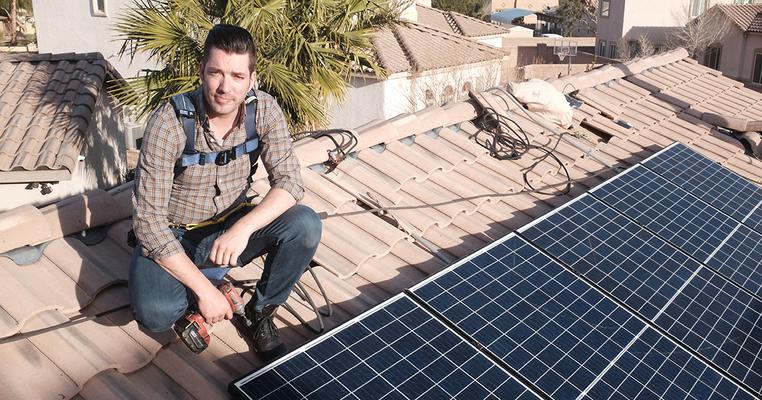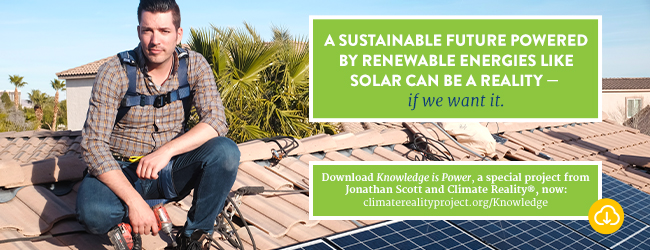
Jonathan Scott Answers Climate Reality’s Solar Energy Questions
Around the world, cities, states, countries, and companies (and people just like you!) are making the switch to clean, renewable solar energy to take control of their energy futures — and because it just makes good economic sense.
At the same time, fossil fuel utilities are engaging in deceptive tactics to try to forestall the inevitable and protect their billions in profits – at the expense of people all over the world trying to live healthy, safe, independent lives.
We’re sure you’ve got a lot of questions. We think Knowledge is Power, a collaborative effort with Property Brother and solar advocate Jonathan Scott, provides the answers you need to take action to support solar energy when it matters the most.
Below, enjoy an excerpt from Knowledge is Power, where Jonathan answers some pressing questions about solar energy. This Q&A has been edited for length and clarity. For the full interview, get your free e-book here.
You and your brother, Drew, have built, bought, and sold houses across North America for the past 20-plus years. From a contractor’s perspective, how would you describe the road to clean, renewable energy?
As building technology continues to improve and price points for that technology continue to drop, we will see renewable energy become more and more prevalent in the average home. I believe we will see battery storage becoming a standard option, and smart systems that will allow you to store produced energy in those batteries or in your electric vehicle when plugged into your home. The prospect of claiming your energy independence, reducing your overhead, and protecting the planet — without even thinking about it — is very exciting!
Solar energy has been around for decades, hasn’t it? Why the big push now?
First of all, I think the most crucial piece of the puzzle is public awareness. People have more options than ever before to do the right thing environmentally, whether it’s recycling your old computer or putting solar panels on your roof. Until now, solar was considered too expensive to be a viable solution for everybody. But all of a sudden, the amount of energy produced by PV panels has increased substantially and the cost of those panels has plummeted significantly — making it now cheaper than fossil fuel alternatives at both the utility scale and for residential use.
Do residential solar energy systems require a lot of maintenance?
No, solar systems are fairly straightforward and require little to no maintenance. The panels themselves generally last about 20 years, which is why major corporations and municipalities prefer them. The fixed costs are easy to plan around. Too much dust or debris on the panel surface can reduce energy production, but Mother Nature usually keeps everything clean with the occasional rain shower. Otherwise, you can just hose it down. I live in Las Vegas, and the panels on my house have withstood years of desert sand blowing around without needing any maintenance.
Will my home solar-electrical system work at night or on rainy days?
Though your solar system will not produce energy in the dead of night, it does still produce energy on cloudy, rainy days. In fact, Germany is one of the world’s leading producers of solar power, with PVs contributing as much as 15 percent to the country’s power mix in a given month. To put that in perspective, Portland, Oregon, averages 2,341 hours of sunshine per year, while most German cities barely top 1,600.
>> Free Download: Knowledge is Power: A Special Report from Jonathan Scott and The Climate Reality Project <<
What happens during a power outage? Does my solar-energy system just automatically kick in? Even in a storm?
If the grid power goes out for any reason, your power still goes out, unless you have back-up battery packs installed in your home, which I highly recommend.
One exciting trend I’m seeing in the building industry is a presumption that solar will be standard in the near future — new construction often includes installation of a home battery or two now, as well as an option, or, in the case of California, a requirement, to put up solar panels. With one or two unobtrusive battery packs hanging on a wall, you’ve got a supply of solar to tap into during an outage. A battery also helps you spread your solar energy into the evening, but keep in mind that most residential battery units right now only cover four circuits in your home, so you’d have to decide what circuits are the most important for you to keep active during a blackout.
Are there ways to access solar power without investing in my own system?
There are many different alternatives, and it’s worth checking out what options may be available where you live, since utilities differ in what they are willing to offer, and regulations vary from state to state and even municipality to municipality. There are two ways to look at solar: One is your ability to reduce your energy costs and put money in your pocket, and the other is your desire to do something environmentally responsible.
If you live in a region that allows net-metering and other credits when your system generates more electricity than you use and sends the excess back to the grid, then your best option is to buy the panels upfront. Most solar companies offer the option to finance the purchase, or to lease you the panels. They’ll want their cut, of course, but you’ll still get to benefit from lower rates and solar energy production for your home minus the burden of the upfront cost.
The third option is to go with a company like Solar City or Sunrun, which will install your system and handle all the maintenance at no cost to you when you sign a contract agreeing to purchase all your energy from them for the next 20 years. Usually, you’ll shave a hair off your utility bill, paying around 95 percent of what you did pre-solar. The downside is that you won’t be able to reap the mass of savings once the system is paid off — but you still get that greater reward of knowing you’re doing something significant to help the environment.
Tell me more about net-metering.
There’s a lot of confusion surrounding net-metering. It is not a subsidy. It is, however, one of the most beneficial programs that makes going solar worthwhile. Net-metering simply allows you to sell your excess energy back to the grid. Every state has different policies in place as to what they will or will not allow. Over 30 states currently offer net-metering, but the practice is continually under attack by special interests that don’t want to fairly share the economic and financial benefits of distributed energy with the customers whose panels have generated it.
Here’s how it basically works: Many solar producers create more energy than they need during the day. That excess can be sold back to the grid for other people to use when demand is high. This “credit” can offset your energy usage at night when your solar panels are not producing.
Are clean renewables like solar and wind energy in position to completely replace existing conventional power systems anytime soon?
Until there is substantial improvement in energy storage technology, there will likely still be a need for diversity in energy production. But experts say we’re closing in on solutions to that battery problem. There are actually hundreds of cities around the world that are 100 percent renewable already. It can be done.
Where do we go from here?
We need to focus on eliminating the dirtiest of the power-producing plants first, which include coal and natural gas. The public health threats they pose can no longer be overlooked or denied. To cite just one example, once burned, coal produces a toxic ash that is typically disposed of in waste ponds. But a new investigation by Earth Justice of the coal industry’s own data found that most of those ponds have no lining, and 242 of 265 — that’s 91 percent — of coal-fired plants with monitoring in place have leaked coal ash into groundwater. Contaminants include arsenic, lead, selenium, radium, and methyl mercury, all of can cause cancer, heart disease, stroke, and permanent brain damage in children.
But fossil fuels have been around forever, literally. Isn’t this like trying to put the genie back in the bottle?
Fossil fuels will still be around for decades to come – we just need to aggressively reduce our dependence on them. But many scientists say it is feasible that within 10 years, the country could be run by 60 percent renewables. That would be a huge step in the right direction. And seeing the trajectory of implementation, it would likely be that within about 16 or 17 years we could be 100 percent renewable... and a global leader in the energy revolution.
And as we substitute dirty energies for clean energies like solar and wind — in a decentralized fashion – we will see air quality improve and respiratory illnesses diminish while gaining far more stability in our national energy system overall.
***
The simple, undeniable fact is this: The sun can provide more energy in an hour than all of humanity uses in a year. We’re talking about an inexhaustible supply of clean, safe, reliable power that people and countries across the planet can access to power their lives and economies.
Even still, fossil fuel utilities continue to make billions of dollars from dirty energy monopolies – while the rest of us pay the consequences.
Learn more about the incredible benefits of solar energy and the deceptive tactics fossil fuel utilities are using to protect their bottom lines at the expense of every person on the planet by downloading Knowledge is Power now.


